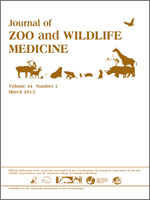Captive cracids (Aves: Galliformes: Cracidae), including endangered species, were studied (n = 130) for the assessment of health status, including Aburria jacutinga (black-fronted piping-guan, n = 42), Crax blumenbachii (red-knobbed curassow, n = 54), Crax fasciolata (bare-faced curassow, n = 28), and Penelope obscura (dusky-legged guan, n = 6). The exposure to Mycoplasma gallisepticum (MG), Mycoplasma synoviae (MS), Salmonella pullorum (SP), Salmonella gallinarum (SG), avian paramyxovirus-1 (APMV-1), and infectious bursal disease virus (IBDV) were determined by serology, and SG and SP also were evaluated by culture. Ectoparasites and endoparasites were identified using light microscopy. Sera were negative by the hemagglutination inhibition (HI) test for antibodies to MG or MS, although serum was reactive to MG (32%, 42/130) by the rapid serum agglutination test (SAT). Although positive reactions (26.9%, 35/130) for SP and SG were detected by SAT, cloacal swab cultures were negative for SP and SG. IBDV antibodies were detected by enzyme-linked immunosorbent assay in two dusky-legged guans (1.5%, 2/130). HI antibody titers to APMV-1 were found in 20 (15.3%) cracids, with titers ranging from 16 to 1,024. Fifty percent of birds (65/130) had ectoparasites. Lice (Menacanthus spp.) and mites (Astigmata: Analgesidae, Megninidae; Megninia spp.) were found in red-knobbed curassow; Megninia spp. also were found in bare-faced curassow, black-fronted piping-guan, and dusky-legged guan. Eleven black-fronted piping-guans presented dual parasitism by Megninia spp. and Ornithonyssus spp. Endoparasites were detected in 16.1% (21/130) of birds, and some with multiple parasites. Oocysts of coccidia and eggs of Capillaria spp. (Nematoda: Trichuroidea) were found in the feces of red-knobbed curassow. Eggs of Strongyloides spp. were found in the feces of bare-faced curassow, and eggs of Ascaridia spp., Capillaria spp., and Strongyloides spp. were found in black-fronted piping-guan. Cysts of Blastocystis spp. were found in dusky-legged guan. Antibodies to IBDV and APMV-1 indicate previous exposure. However, considering that birds were clinically normal, immune stimulation might have been from live chicken vaccine strain infections that are widely used in Brazilian poultry. The high parasitism levels indicate that a routine inspection for internal and external parasites is warranted.
How to translate text using browser tools
1 March 2013
SEROLOGIC, PARASITIC, AND BACTERIOLOGIC ASSESSMENT OF CAPTIVE CRACIDS (AVES: GALLIFORMES: CRACIDAE) IN BRAZIL
Marcus Vinícius Romero Marques,
Francisco Carlos Ferreira Junior,
Danielle de Assis Andery,
André Almeida Fernandes,
Alessandra Vitelli de Araújo,
José Sérgio de Resende,
Nelson Rodrigo da Silva Martins
ACCESS THE FULL ARTICLE
Aburria jacutinga
cracid
Crax blumenbachii
Crax fasciolata
health status
Penelope obscura





